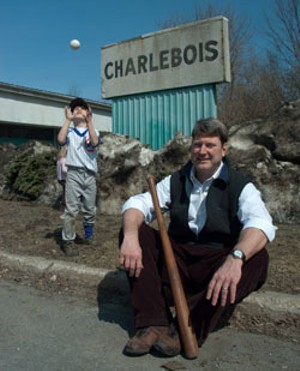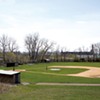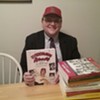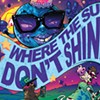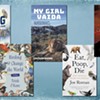Published April 13, 2011 at 7:03 a.m. | Updated May 19, 2020 at 5:20 p.m.
Once upon a time, the University of Vermont fielded one of the greatest college baseball teams in history. That’s especially impressive for a school that currently doesn’t even have a baseball program.
From 1890 to 1893, the UVM baseball team was regarded as one of the finest in the country, racking up an astounding 129-57-4 record against college teams, semipro barnstorming squads and two National League clubs. Their dominance earned them the nickname the “Wonder Team.”
In 1893, the UVM nine competed in, and nearly won, the baseball tournament at the Chicago World’s Fair. The tourney, organized by the Columbian National Inter-Collegiate Baseball Association, was a precursor to the current National Collegiate Athletic Association (NCAA) baseball championship, the College World Series. It is believed to be the first major intercollegiate athletic tournament of its kind in any sport.
In his new book, The Wonder Team in the White City: U.V.M. at the Intercollegiate Base Ball Tournament of 1893, Burlington author, lawyer and baseball historian Tom Simon digs into the unusual story of the Wonder Team. Using archival news clippings — often from UVM’s student newspaper, the Cynic — and letters and essays from players, fans and boosters, he reconstructs the team and its personalities. In doing so, Simon reveals not only a snapshot of a seminal era in baseball but the origins and importance of the sport in Vermont.
Simon first discovered the Wonder Team while doing research for The Green Mountain Boys of Summer: Vermonters in the Major Leagues 1887-1993, a book he contributed to and edited. That book, released in 2000 and written with other members of the Vermont chapter of the Society for American Baseball Research — a chapter Simon founded after moving to the state in 1993 — profiled Vermont-born players who had made the major leagues. Several of them were Wonder Team alums.
“I’d always been interested in learning more about that team, but, at the time, it was beyond the scope of that book,” Simon says, referring to Boys of Summer.
Nearly 10 years — and two kids — later, Simon finally delved into the Wonder Team. Ironically, the timing of his research into UVM’s fabled club coincided with the school’s 2009 decision to cut both its varsity baseball and softball programs. Simon says he regrets not having had the chance to do his research sooner, and wonders whether pointing out baseball’s historical importance to the university might have helped win the program a stay of execution.
“In the early days of their athletic program, it really was the sport,” he laments. Simon adds that several members of the team went on to become trustees of the school. “They would be turning over in their graves if they knew UVM had cut its baseball team,” he declares.
Like many baseball fans, Simon inherited his passion for the game from his father, who played college baseball and had a brief stint in the minor leagues. Simon played baseball growing up, but he was just as interested in the game’s history. When he was 12 years old, he read The Glory of Their Times: The Story of Baseball Told by the Men Who Played It. Lawrence S. Ritter’s vivid oral history of the game from the turn of the 20th century into the “Dead Ball Era” fascinated Simon and hooked him for life.
“It grabbed me,” he says.
Simon was also an avid baseball-card collector as a child in the 1970s. He recalls trading with a friend whose father collected tobacco cards — an early-1900s form of advertising that used baseball players’ images to market tobacco products. Simon would offer handfuls of then-commonplace cards — Mike Schmidt, Hank Aaron, Pete Rose — for one or two tobacco cards from 1908 or 1910.
“It was like holding a piece of history,” he says of the tobacco cards. “It got me more interested in baseball in the 1900s than in baseball in the 1970s.”
Now Simon has created his own piece of baseball history that is likely to intrigue avid fans. And the book may surprise anyone who views the game in Vermont as an afterthought — which, considering the lack of a UVM squad and the uncertain future of the Single-A Vermont Lake Monsters, is an understandable misperception.
So, how did UVM, a small school in a geographically disadvantageous location — both in terms of climate and distance from other schools at a time when traveling was more arduous — become a baseball powerhouse?
They, um, pretty much cheated. Sort of.
Fans tend to look on baseball’s earliest era as its halcyon days. Especially in light of contemporary steroid scandals that have tarnished the game, some believe the game used to be purer. It wasn’t.
Simon discovered that UVM’s baseball team was almost certainly guilty of recruiting improprieties that would make Cam Newton’s dad blush. These unseemly activities, fueled by community boosters but never explicitly condemned by school officials, included signing non-amateur players, actively recruiting players from rival schools and enrolling players in academic programs for which they were clearly unqualified. To the last point, Simon recounts a letter written by a UVM player named E.N. Sanctuary. Among other candid, and rather comical, insinuations of shady dealings, Sanctuary cites then-UVM president Matthew Buckham, who was overheard to remark of star catcher and English major Larry Kinsella that “Kinsella’s English was very bad.” Sanctuary also not-so-subtly implied that financial incentives were given to several players.
“One thing I’ve learned from my reading is that people haven’t changed that much,” says Simon, comparing UVM’s iffy practices to latter-day sports transgressions. He points out that college sports at the time had no real governing body — the NCAA wouldn’t exist for another 17 years — so UVM wasn’t technically breaking any rules. “But that stuff does make the story more interesting,” Simon adds.
“It’s amazing how much continuity there is in the history of baseball,” he says. Simon cites the introduction of the American League’s still somewhat controversial designated-hitter rule in 1972 as an example. The idea had actually been proposed in the early 1900s because of frustrations over the inability of pitchers to hit. “[Players have always done] anything to gain a competitive advantage,” he says. “Are the guys doing performance-enhancing drugs now that much different from the guys who were corking bats or scuffing baseballs?”
Suspect recruiting aside, Simon’s history presents a unique look into the development of the Wonder Team and helps illustrate a truly unusual period of baseball history. The Wonder Team also offers a surprising lesson in karma.
In the book’s climactic scene at the tournament in Chicago, UVM is undone by its arch-rival, Yale, and Yale’s center fielder, Harmon Sheldon Graves. Graves was a Burlington native who had transferred from UVM to Trinity College to play football when Vermont canceled its pigskin program. He also played summer baseball for UVM, but was a law student at Yale at the time of the tourney. Graves hit the game-winning triple that sent UVM home. Yale went on to defeat Amherst College and win the championship.
“All these things that in the 21st century would be violations … come back to haunt UVM,” says Simon. “Because this guy from Burlington ends up getting the hit that knocks them out of the tournament.”
Info
The Wonder Team in the White City: U.V.M. at the Intercollegiate Base Ball Tournament of 1893 by Tom Simon, Gardner-Waterman Press, 131 pages. $15.
More By This Author
About the Artist

Matthew Thorsen
Bio:
Matthew Thorsen was a photographer for Seven Days 1995-2018. Read all about his life and work here.
Matthew Thorsen was a photographer for Seven Days 1995-2018. Read all about his life and work here.
Speaking of Sports
-

UVM Swimming and Diving Overcomes Budget Cuts to Win Conference for the First Time in Its History
Mar 13, 2024 -

Two Vermont Teens Take On the Cross-Country Junior National Championships
Mar 6, 2024 -

Youth Soccer Comes of Age in Vermont, but the Playing Field Is Hardly Level
Nov 1, 2023 -

In a Classic Vermont Mountain Road Rally, Winning Takes Precision and Smarts, Not Speed
Sep 20, 2023 -

True Grit: Gravel Biking in Vermont Is Gaining Traction and Building Community
Apr 26, 2023 - More »
Comments
Comments are closed.
From 2014-2020, Seven Days allowed readers to comment on all stories posted on our website. While we've appreciated the suggestions and insights, right now Seven Days is prioritizing our core mission — producing high-quality, responsible local journalism — over moderating online debates between readers.
To criticize, correct or praise our reporting, please send us a letter to the editor or send us a tip. We’ll check it out and report the results.
Online comments may return when we have better tech tools for managing them. Thanks for reading.


































